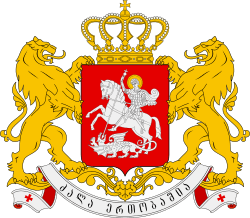Byzantine–Georgian wars
| Byzantine-Georgian wars | |||||||
|---|---|---|---|---|---|---|---|
 | |||||||
| |||||||
| Belligerents | |||||||
|
|
| ||||||
| Strength | |||||||
|
Potential to raise 250,000 c.1025 up to 50,000 Field troops in 1140. | Varying, eventually much fewer | ||||||
The Byzantine–Georgian wars (Georgian: ბიზანტიურ-ქართული ომები) were a series conflicts fought during the 11th century and were mainly focused on several strategic districts in the Byzantine-Georgian-Armenian marchlands. Most of these lands were granted by Emperor Basil II to the Georgian courapalates David III of Tao in reward for his crucial assistance in the struggle against the rebel general Bardas Sklerus (978–79). However, David supported another unsuccessful noble revolt led by Bardas Phocas at the end of the 980s. As a result, David was forced to make Basil II the legatee of his princedom. This agreement destroyed a previous arrangement by which David had made his adopted son, Bagrat III of Georgia, his heir. When David died early in 1000, Basil added his inheritance – Tao, Theodosiopolis (aka Karin, Karnu; the present day Erzurum), Phasiane and the Lake Van region (Apahunik) with the city of Manzikert – to the Byzantine Empire. The following year, the Georgian prince Gurgen, natural father of Bagrat, marched to take David’s inheritance, but was thwarted by the Byzantine general Nikephoros Ouranos, dux of Antioch. Despite these setbacks, Bagrat was able to become the first king of the unified Georgian state in 1008. He died in 1014, and his son, George I, inherited a longstanding claim to those territories in Tao which were in Byzantine hands.
Georgian campaigns of Basil II
| History of Georgia |
|---|
 |
|
History by topic |
|
|
.jpg)
George I invaded and occupied Tao and Phasiane in 1014. Basil, involved in his campaign against the Bulgarians, sent an army to expel the Georgians. This army was decisively defeated, but a Byzantine naval force occupied the Khazar ports in the rear, that is, to the north-west, of George's dominions. Once, the annexation of Bulgaria was completed in 1018, preparations for a larger-scale campaign were set in train, beginning with the re-fortification of Theodosiopolis. In the autumn of 1021, Basil ahead of a large army, reinforced by the Varangian Guards, attacked the Georgians and their Armenian allies, recovering Phasiane and pushing on beyond the frontiers of Tao into inner Georgia. King George burned the city of Oltisi keep it out of the enemy’s hands and retreated to Kola. A bloody battle was fought near the village Shirimni at the Lake Palakazio (now Çildir, Turkey) on September 11 and the emperor won a costly victory, forcing George I to retreat northwards into his kingdom. Plundering the country on his way, Basil withdrew to winter at Trabzond. Several attempts to negotiate the conflict went in vain and, in the meantime, George received reinforcements from the Kakhetians, and allied himself with the Byzantine commanders Nicephorus Phocas and Nicephorus Xiphias in their abortive insurrection in the emperor’s rear. In December, George’s ally, the Armenian king Senekerim of Vaspurakan, being harassed by the Seljuk Turks, surrendered his kingdom to the emperor. During the spring of 1022, Basil launched a final offensive winning a crushing victory over the Georgians at Svindax. Menaced both by land and sea, King George handed over Tao, Phasiane, Kola, Artaan and Javakheti, and left his infant son Bagrat a hostage in Basil's hands.
Georgian civil wars and end of the conflict

On the death of his father, Bagrat returned home to become King Bagrat IV of Georgia in 1027. However, a powerful party of Georgian nobles led by Bagrat's distant cousin Demetre, son of Gurgen of Klarjeti, refused to recognize his suzerainty, and invited a Byzantine army in 1028. The Byzantines overran the Georgian borderlands and besieged Kldekari, a key fortress in Trialeti province, but failed to take it and marched back on the region Shavsheti. The local bishop Saba of Tbeti organized a successful defense of the area forcing the Byzantines to change their tactics. The emperor Constantine VIII then sent Demetrius, an exiled Georgian prince, who was considered by many as a legitimate pretender to the throne, to take a Georgian crown by force. This incited a new tide of the rebellion against Bagrat and his regent, queen dowager Mariam of Vaspurakan. In the end of 1028, Constantine died, and the new emperor Romanus III recalled his army from Georgia. Queen Mariam visited Constantinople in 1029/30 and negotiated a peace treaty between the two countries.
Early in the 1040s, a feudal opposition staged another revolt against Bagrat IV of Georgia. The rebels led this time by Liparit IV, Duke of Kldekari, requested a Byzantine aid and attempted to put Prince Demetrius on the throne. Yet, despite their efforts to take a key fortress Ateni went in vain, Liparit and the Byzantines won a major victory at the Battle of Sasireti in 1042 forcing Bagrat to take refuge in the western Georgian highlands. Soon Bagrat headed for Constantinople and, after the three years of negotiations achieved his recognition by the Byzantine court. Back to Georgia in 1051, he was able to force Liparit into exile. This was the actual end of the Byzantine-Georgian conflicts.
Reconquest and establishment of the Trapezuntine kingdom
Despite the territorial losses to Basil II, the Georgian kings succeeded in retaining their independence and in uniting most of the Georgian lands into a single state. Many of the territories ceded to the empire were conquered by the Seljuk Turks towards the 1070s-1080s, but were then retaken by the Georgian King David IV. Relations between the two Christian monarchies were then generally peaceful except for the episode of 1204, when Tamar of Georgia took advantage of the Fourth Crusade against Constantinople, and invaded the Black Sea provinces of the empire to help the Comnenus princes to found the Trapezuntine kingdom.
